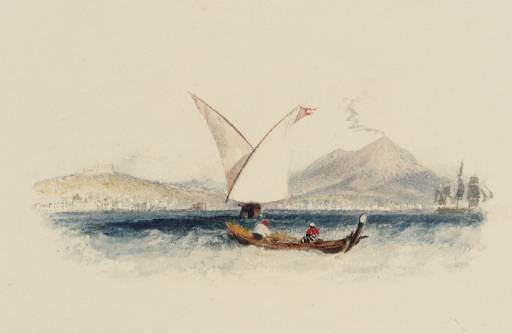Joseph Mallord William Turner Bay of Naples, for Rogers's 'Italy' c.1826-7
Joseph Mallord William Turner,
Bay of Naples, for Rogers's 'Italy'
c.1826-7
Joseph Mallord William Turner 1775–1851
Bay of Naples, for Rogers’s ‘Italy’ circa 1826–7
D27660
Turner Bequest CCLXXX 143
Turner Bequest CCLXXX 143
Gouache, pencil and watercolour, approximately 68 x 160 mm on white wove paper, 235 x 305 mm
Stamped in black ‘CCLXXX 143’ bottom right
Stamped in black ‘CCLXXX 143’ bottom right
Accepted by the nation as part of the Turner Bequest 1856
Exhibition history
1904
National Gallery, London, various dates to at least 1904 (201).
References
1903
E.T. Cook and Alexander Wedderburn (eds.), Library Edition: The Works of John Ruskin: Volume I: Early Prose Writings 1834–1843, London 1903, pp.233, 244.
1904
E.T. Cook and Alexander Wedderburn (eds.), Library Edition: The Works of John Ruskin: Volume XIII: Turner: The Harbours of England; Catalogues and Notes, London 1904, pp.380–1.
1906
E.T. Cook and Alexander Wedderburn (eds.), Library Edition: The Works of John Ruskin: Volume XXI: The Ruskin Art Collection at Oxford, London 1906, p.214.
1909
A.J. Finberg, A Complete Inventory of the Drawings in the Turner Bequest, London 1909, vol. II, p.899, as ‘Naples’.
1966
Adele Holcomb, ‘J.M.W. Turner’s Illustrations to the Poets’, unpublished Ph.D thesis, University of California, Los Angeles 1966, p.41.
1979
Andrew Wilton, The Life and Work of J.M.W. Turner, Fribourg 1979, p.439 no.1172, reproduced.
1990
David Blayney Brown, The Art of J.M.W. Turner, London 1990, p.167.
1993
Jan Piggott, Turner’s Vignettes, exhibition catalogue, Tate Gallery, London 1993, p.96.
This vignette appears as the head-piece to the fortieth section of Rogers’s Italy, also entitled ‘Naples’.1 It was engraved by Edward Goodall, who was one of the most prolific and skilled interpreters of Turner’s designs.2 This charming scene shows the Bay of Naples on a clear day with several boats gliding along its calm water. The city of Naples unfolds along the distant shore, while the towering form of a gently smoking Mount Vesuvius rises in the background.
In the opening verses of this section which appear just below this vignette, Rogers praises the heavenly beauty of the city and its natural surroundings:
This region, surely, is not of the earth.
Was it not dropt from heaven? Not a grove,
Citron or pine or cedar, not a grot
Sea-worn and mantled with the gadding vine,
But breathes enchantment. Not a cliff but flings
On the clear wave some image of delight,
Some cabin-roof glowing with crimson flowers,
Some ruined temple or fallen monument,
To muse on as the bark is gliding by.
(Italy, pp.189–90)
Was it not dropt from heaven? Not a grove,
Citron or pine or cedar, not a grot
Sea-worn and mantled with the gadding vine,
But breathes enchantment. Not a cliff but flings
On the clear wave some image of delight,
Some cabin-roof glowing with crimson flowers,
Some ruined temple or fallen monument,
To muse on as the bark is gliding by.
(Italy, pp.189–90)
Turner’s view of the Bay echoes the idyllic scene described above. The thin plume of smoke that emerges from the peak of Vesuvius alludes to its destructive potential without marring the carefree and exuberant mood of this light-filled scene. Although Vesuvius is most famous for destroying the Roman city of Pompeii in 79 AD, it was also unusually active in the eighteenth and nineteenth centuries, erupting six times in the eighteenth century and again in 1822, less than a decade before the publication of Rogers’s Italy.
In designing the composition, Turner may well have referred to the many drawings of the Bay of Naples that he made during his visit there in 1819, although none of his on-site studies appear to have served as direct models for this view of the bay (see the Gandolfo to Pompeii, Amalfi sketchbook, Turner Bequest CLXXXV and Naples, Paestum, and Rome sketchbooks, Turner Bequest CLXXXVI). He also produced at least one unfinished preparatory study (see Tate D27530; Turner Bequest CCLXXX 13). It is possible that another study of distant mountains set against a fiery sunset is also related to this vignette (see Tate D27541; Turner Bequest CCLXXX 24).
Naples was at this time a larger and more cosmopolitan city than Rome and ranked high on the list of destinations for those on the Grand Tour. It was, like Rome, steeped in antiquity and tradition, as well as being renowned for its physical attractions. The view from the Bay was considered to be one of the finest in Europe. By the time of Italy’s production, however, Naples was home to growing political instability and its popularity among British tourists was on the wane. In light of these circumstances, it is possible that Turner’s limpid palette is intended to suggest a vision of Naples in decline.3
Verso:
Inscribed by unknown hands in pencil ’21’ top left and ‘1 a’ centre and ‘CCLXXX 143’ bottom centre. Also inscribed in ink ‘1024’ bottom left
Stamped in black ‘CCLXXX–143’ lower centre
Stamped in black ‘CCLXXX–143’ lower centre
Meredith Gamer
August 2006
How to cite
Meredith Gamer, ‘Bay of Naples, for Rogers’s ‘Italy’ c.1826–7 by Joseph Mallord William Turner’, catalogue entry, August 2006, in David Blayney Brown (ed.), J.M.W. Turner: Sketchbooks, Drawings and Watercolours, Tate Research Publication, December 2012, https://www

